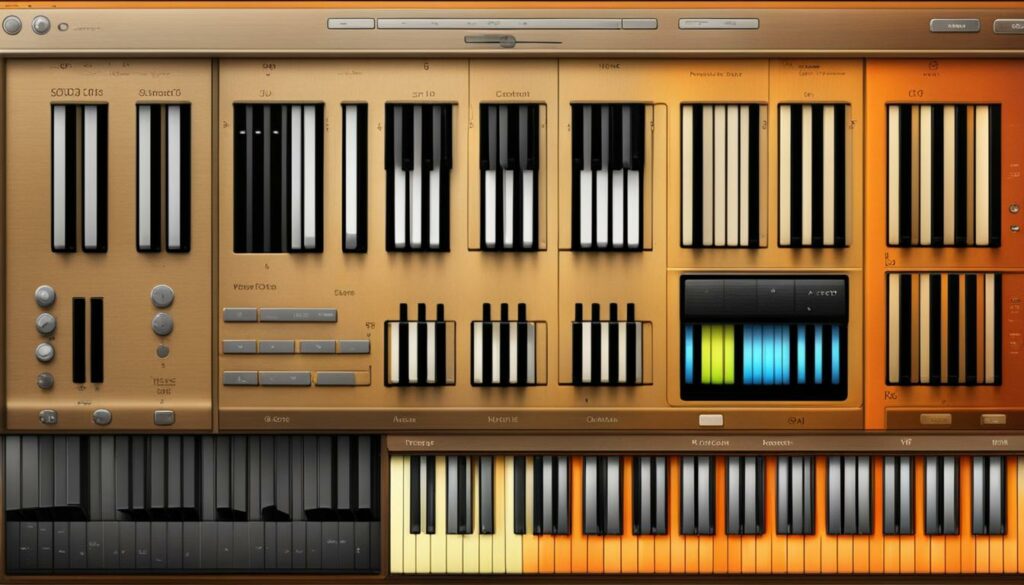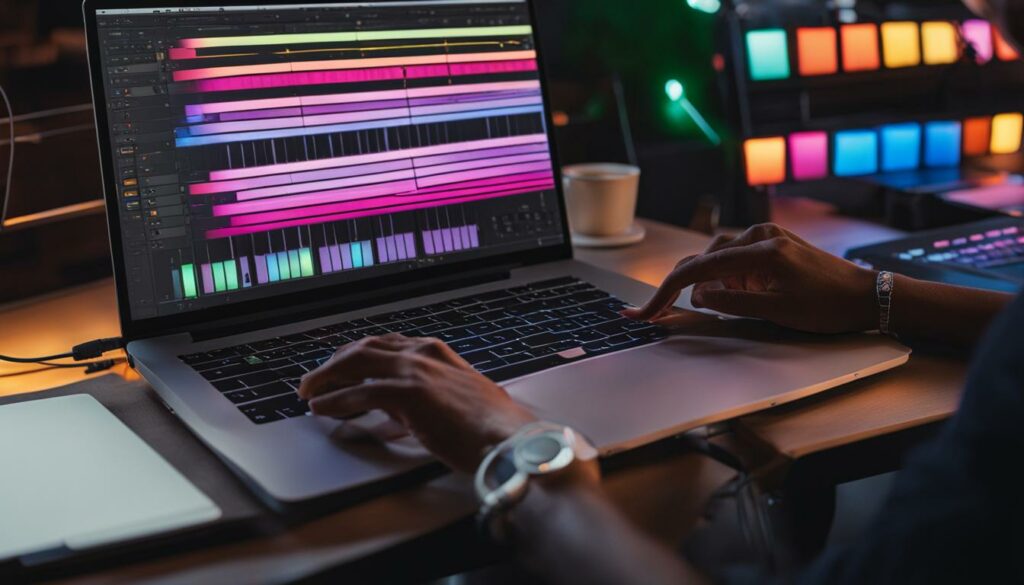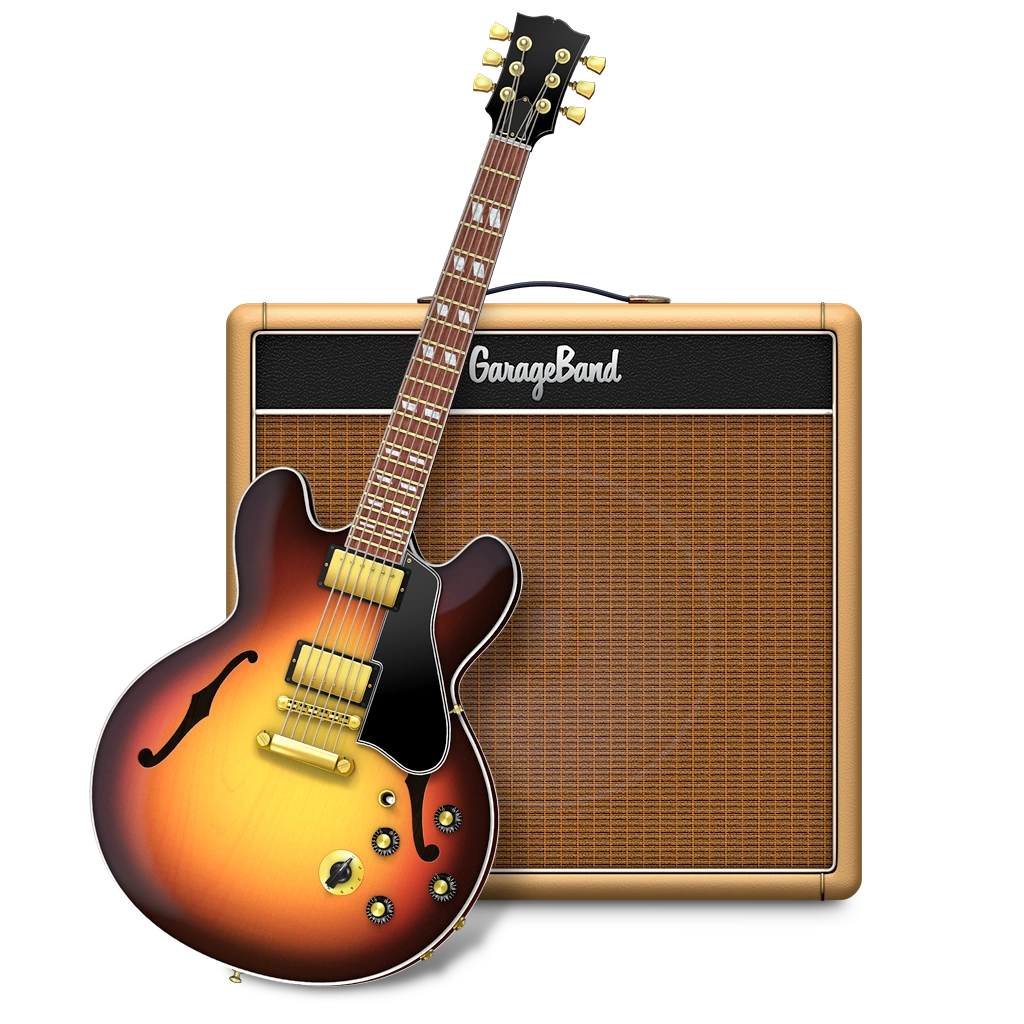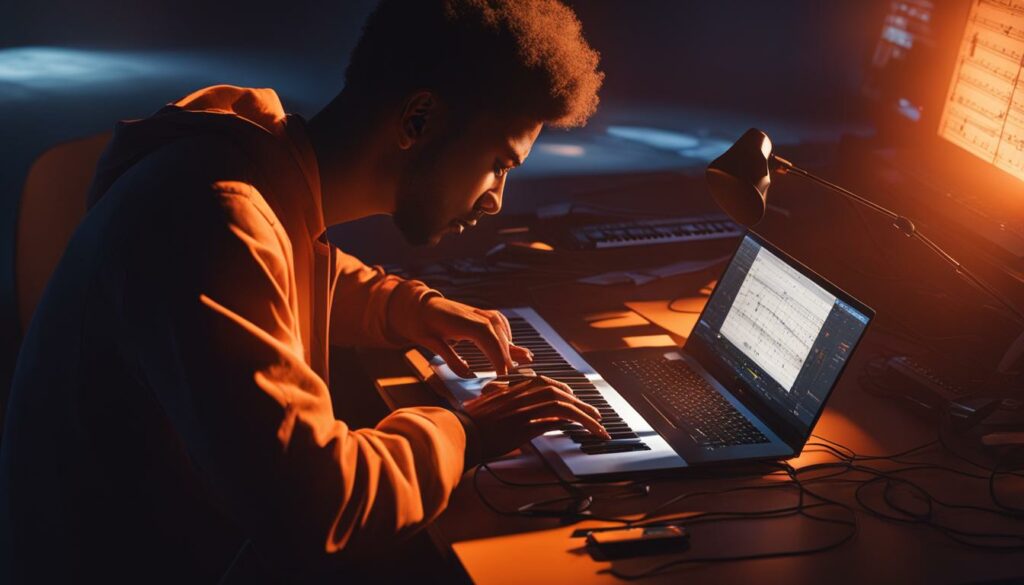Embrace the symphonic possibilities at your fingertips with GarageBand, the quintessential piano app for music makers of all stripes. From the melodious allure of the grand piano to the futuristic vibe of the synthesizer, this is where we uncover the secrets of how to play piano on GarageBand. Engaging, versatile, and supremely user-friendly, GarageBand transforms your device into an orchestra of piano sounds and an educational avenue for pianists yearning to blossom.
Introduction to GarageBand’s Virtual Piano
We understand the allure of piano mastery, and with GarageBand’s virtual piano, that mastery is closer than ever. Whether you’re a seasoned pianist or someone taking their first steps in music creation, GarageBand offers an immersive piano experience, replete with a variety of keyboard sounds and intuitive controls tailored to your artistic vision.
Exploring the Main Features of GarageBand’s Piano
Delving into the heart of GarageBand’s keystroke magic, you’ll discover a suite of features designed to fulfill your musical quests. Each tap and swipe on your device brings to life the rich tones of grand pianos, the funky vibes of electric pianos, and the avant-garde soundscapes of synthesizers. The Alchemy synth elevates this experience, offering an advanced control set for crafting the perfect sound. This is an ideal playground for novices eager to partake in beginner piano lessons on GarageBand.
Navigating GarageBand’s Interface for Piano
Our journey through the harmonious labyrinth of GarageBand’s piano settings is made effortless thanks to its user-friendly interface. Selecting the right keyboard sound becomes a breeze, as does the process of diving into various categories to find the tone that speaks to your musical narrative. Step into the world of octaves with a simple tap, and embrace the sustain control for those prolonged, emotive notes. The customizable touch sensitivity lays the foundation for you to express your piano playing techniques on GarageBand with precision, reflecting the nuances of your unique touch.
Adapting to your style, GarageBand’s virtual piano not only houses the potential for limitless creativity but also serves as an invaluable tool for a comprehensive piano tutorial on GarageBand. It’s time to let your fingers dance across the digital ivory and let the music within flow forth.
Setting Up Your Piano Instrument on GarageBand
Embarking on the journey of how to play piano on GarageBand starts with setting up your virtual piano instrument. We dive into the app’s intuitive layout, where a multitude of keyboard sounds await your selection. Be it a classical grand piano or a smooth electric piano, the choice lies at your fingertips, ready to adapt to the ambiance of your musical piece. For those seeking piano lessons on GarageBand, this initial step is pivotal—it acquaints you with the digital realm of piano timbres and sets the stage for your melodic explorations.
To efficiently traverse across the keyboard, GarageBand enables you to swiftly move through different octaves with a mere tap. This feature proves invaluable for expanding the expressive range of your compositions, allowing both low and high notes to coalesce, enriching the tapestry of sound you weave. The ease with which you can scale the octaves incorporates flexibility into your piano lessons on GarageBand, cementing a robust foundation for your progression.
How a piano responds to the touch can deeply influence a performance, and GarageBand’s touch sensitivity control mirrors that of an actual keyboard. By selecting a suitable touch sensitivity level, you can infuse your melodies with dynamic nuances, making each note resonate with intentional force or gentle whisper. This precision in expression personalizes your piano lessons on GarageBand, crafting an experience that closely aligns with playing on a physical keyboard.
Whether you’re a burgeoning pianist or a maestro in the making, understanding and configuring these settings is the crux of how to play piano on GarageBand. From adjusting touch sensitivity to exploring the vast array of keyboard sounds, these elements harmonize to serve beginner piano lessons on GarageBand, shaping a truly tailored and immersive learning environment. We’re here to ensure that your pathway to pianistic prowess on GarageBand is limpid and exhilarating.
Selecting the Right Piano Sound for Your Project
In the realm of GarageBand’s diverse and authentic piano sounds, choosing the right tone for your composition is paramount. As we navigate through the options within this app, we find ourselves faced with the delightful conundrum of selecting between the classical resonance of a grand piano and the modern timbres of an electric piano. Each carries a unique voice capable of altering the very essence of your music.
Comparing Grand Piano and Electric Piano Sounds
The grand piano’s sounds imbue your tracks with richness and a timbral complexity that conjures the atmosphere of concert halls and intimate jazz clubs alike. It’s an indispensable choice for those aiming to convey sophistication and timeless magnificence through their tunes. Conversely, the electric piano brings forth a distinctly different flavor—crisp, punchy, and often linked with funk, R&B, and jazz fusion. The variety in GarageBand piano sounds ensures the adaptability and enriches our palette for a thorough and insightful piano tutorial on GarageBand.
Customization stands as a powerful feature that we, as artists and educators, harness in GarageBand. With controls specifically designed for different piano sounds, such as the detailed knobs regulating the distinctive warble of electric pianos or the Transform Pad for Alchemy synth sounds, we are freed to shape and fine-tune our sonic output. These tools are integral for crafting a personalized experience within a piano tutorial on GarageBand, extending our creative boundaries and enabling the tailored articulation of each note and chord.
The journey of selecting the perfect garageband piano sound is a formative step in composing music or constructing a piano tutorial on GarageBand. It is not merely about finding a preset but about understanding the impact each sound has and how it merges with your musical vision. Join us as we explore, manipulate, and ultimately discover the piano sound that resonates with our project’s heart.
Adjusting the Octave and Sustain for Dynamic Playing

As we delve into the world of piano exploration on GarageBand, we’re met with the capability to enhance our musical expressiveness. An essential aspect of this journey, especially for those starting with beginner piano lessons on GarageBand, is understanding how to manipulate the octave range and sustain settings. These features create a dynamic playing environment that’s both educational and deeply musical.
Our virtual piano’s octave controls are pivotal for novice pianists. By adjusting these settings, we can coax out soaring high notes that glisten with clarity, or plunge into the deep, sonorous low notes that give music its powerful undertones. This breadth of sound is crucial when navigating through garageband piano settings, offering us a spectrum of expressive options.
Sustain, on the other hand, allows for a note’s resonance to linger in the air, adding depth to the compositions. Understanding and utilizing the sustain function is a stepping stone in beginner piano lessons on GarageBand. It offers a taste of emotionality and complexity, traits that pervade the piano’s history as an instrument of expression. By adjusting the length of the sustain, we dictate the mood and the connective tissue between notes and chords. It’s the tool that enables legato passages to blend smoothly, or staccato lines to punctuate with purpose.
Adjusting the octave and sustain is more than just a learning feature; it’s an opportunity to discover the full range of dynamic expressions inherent in music composition and performance. Within the touch of your fingertips lies the power to captivate and command attention through the nuanced customization of GarageBand’s piano. These adjustments live at the heart of a truly personalized piano practice experience.
With every adjustment to octaves and sustain, notes leap to life, emboldening us with the confidence to push beyond the novice stage. Recognize these pivotal modifications as part of your piano toolkit on GarageBand. They exemplify the foundation upon which we can grow as musicians, and their mastery is a testament to our ongoing development in musical artistry.
Customizing Touch Sensitivity for Personalized Expression
As aficionados of the piano app for GarageBand, we recognize that the essence of piano performance lies not only in the notes themselves but in the unique expression of each individual artist. Touch sensitivity, or velocity sensitivity, is the cornerstone of this personalized expression on the virtual piano. To truly bring our piano playing techniques on GarageBand to life, we delve into the nuances of touch, ensuring every keystroke communicates the intended emotive and dynamic quality.
Finding the Ideal Velocity Sensitivity Settings
Your interaction with the virtual keys on GarageBand can be as diverse as the music you create. Whether you prefer a gentle touch that whispers softly through the speakers or a forceful press that commands attention, finding the ideal velocity sensitivity setting is key. Within GarageBand, we can adjust this sensitivity to one of four distinct levels or opt to turn it off, granting us the utmost control over the loudness of notes based on how intensely we tap the keys.
For those of us who lean towards a more classical approach, a higher touch sensitivity mirrors the responsiveness of a grand piano, responding intimately to our nuanced playing. In contrast, settings with lower sensitivity are perfect when we aim to achieve a consistent level of intensity in our performance, beneficial for genres like rock or pop, where uniformity in note volume often takes center stage. We shape our piano playing techniques on GarageBand with a precision that reflects our individuality and intention.
Invariably, the beauty of using this piano app for GarageBand lies in its flexibility. It allows us to experiment and customize our virtual piano playing experience down to the slightest detail. By adjusting the velocity sensitivity to suit our touch, we are empowered to pour our essence into every melody and chord progression, making each performance unmistakably ours.
Exploring the Innovative Chord Strips Feature

Transcending the barriers to complex piano chords, we proudly spotlight GarageBand’s chord strips—a transformative tool that harmonizes simplicity with sophistication. For our community embarking on beginner piano lessons on GarageBand, these chord strips serve as an empowering portal to the vast world of harmony without the steep learning curve typically involved in mastering chords and bass notes.
Imagine, with a single tap, being able to evoke the spirit of a jazz ensemble or the depth of a classical masterpiece. This stands at the essence of what makes the chord strips so invaluable. It allows us to include instantly rich, diverse chords into our music—be it during a spontaneous improvisation session or an organized piano tutorial on GarageBand.
The innovation doesn’t cease with ease of use; we delve into customization, an aspect that invigorates our piano sessions with limitless creative potential. By modifying chord strips with our very own chord voicings, we tailor the sound to fit the narrative of our compositions perfectly. This facet of GarageBand elevates our musical expression and is a significant advantage for those of us crafting a personalized piano tutorial on GarageBand.
Through the use of chord strips, students of piano can glimpse the profound capabilities of chordal playing, all while laying down the foundation for deeper musical understanding. This showcases the power and potential of GarageBand as an educational tool. We’re delighted to bring this transformative feature into the limelight, underlining its role as an integral part of our collective musical journey.
Creating Your Own Melodies: The Art of Musical Typing
For those of us devoted to perfecting the craft of digital composition, GarageBand paves the way with features that encompass both accessibility and musicality. Dive into piano lessons on GarageBand and you’ll soon discover how the act of creating melodies unfolds into an exciting form of art—thanks to the innovative musical typing feature. This tool bridges the gap between traditional piano skills and the digital music realm, adding an array of possibilities for both seasoned composers and novices alike.
Our exploration into piano tutorial on GarageBand uncovers two potent methods of melody creation—the onscreen keyboard and the musical typing feature, specifically designed for Mac users. These methods seamlessly integrate hands-on music theory with the digital interface, offering a real-time composition experience that is both immersive and intuitive.
Utilizing the Onscreen Keyboard Versus Musical Typing
The onscreen keyboard serves as a visual map of the piano, mirroring the layout of traditional keys, which beckons us to interact directly with its virtual ivories. This visual guidance is indispensable for us as it aids in learning new compositions and honing our dexterity. With this tool, our fingers gingerly tap or boldly strike each key to produce sounds that range from the delicate pitter-patter of raindrops to the resounding roar of thunder.
Meanwhile, musical typing transforms the cumbersome letters and symbols of our computer’s keyboard into a set of piano keys, each assigned to a corresponding note. In this space, our familiar typing dexterity morphs into musical expression. QWERTY keyboards become our pianos, and each keystroke is a note, chord, or creative riff. The utility of this feature shines in its ability to blend regular computer usage with the creation of music, thereby turning a mundane instrument into a source of rhythmic joy.
Whether our trajectory involves formal piano lessons on GarageBand or a self-taught piano tutorial on GarageBand, the capability to craft melodies through either the onscreen keyboard or musical typing is a testament to the versatility of GarageBand. We rejoice in the luxury of choice—that no matter our preference, the music we envision can be brought to life with ease and grace.
Integrating Loops and Samples: A Quick Start to Piano Music
Embarking on a musical expedition has never been easier for us, thanks to the rich library of Apple Loops within GarageBand. These loops provide us with a shortcut to excellence, enabling us to compose piano music with breathtaking ease. Whether we’re aspiring musicians honing our skills on how to play piano on GarageBand or seasoned pros tinkering with new tunes, these loops are a game-changer. They streamline the creative process, introducing us to a world where melody and rhythm coexist harmoniously, awaiting our personal touch.
Accessing and Applying Apple Loops for Piano
Our exploration within the piano app for GarageBand reveals a treasure trove of Apple Loops specifically curated for piano compositions. These predesigned loops, which include everything from jazzy riffs to classical progressions, are not only copyright but also royalty-free. They serve as an invitation to dive right into music creation without fretting over the technicalities of sound design or the intricacies of composition.
We simply glide into the loop browser, handpick the perfect loop that resonates with our project’s vibe, and, with a quick drag and drop, flawlessly integrate it into our project timeline. This simplicity empowers us, regardless of skill level, to create luscious piano backdrops for our songs or even craft entire pieces centered around these evocative loops. They are the virtual soil in which our musical ideas grow—nurtured by the ingenuity of GarageBand.
No longer are we chained to the conventional methodologies of producing music. The loops are stepping stones on the path to discovery, underpinning our compositions with robust, professional-sounding foundations. We leverage these presets to crystallize our musical visions, building upon them until the once-simple loops bloom into complex, emotive compositions. This is the beauty of GarageBand—a piano app that respects our time and amplifies our creative prowess, allowing us to compose with confidence and flair.
Enhancing Your Play with GarageBand’s Advanced Piano Settings
As we venture deeper into the musical fabric of GarageBand, we unveil the advanced piano settings that are instrumental in refining our piano playing techniques on GarageBand. With a myriad of customizable options at our disposal, the capacity for expressive play is vast, enabling us to imbue each performance with our signature style.
Central to these advanced features is the nuanced adjustments in touch sensitivity. This sophisticated level of control allows us to dial in the perfect responsiveness, ensuring that our expressive intentions are captured with every keystroke. Whether it’s the delicate touch on a pensive ballad or the vehement strikes during a powerful chorus, the control is quite literally at our fingertips, a fundamental component in the garageband piano settings that defines our musical expression.
Equally transformative are the Alchemy synth controls, an alchemist’s dream for sound customizability. With parameter knobs that open the door to sonic manipulation, our explorations in sound can lead to breathtaking auditory landscapes. These controls are akin to paintbrushes for audio, with which we can stroke broad thematic textures or intricate tonal details into our compositions.
The innovation doesn’t halt with tactile and sonic adjustments; it continues with the pioneering use of Face Control. Here, our facial expressions become an extension of our musicality, allowing us to add vibrato, resonance, and other dimensions to our piano sounds. This advanced feature demonstrates a commitment to empowering our piano playing techniques on GarageBand, transforming mere notes into a dynamic storytelling medium.
Each dialed-in setting within these advanced piano configurations opens up new avenues for creative play. They are the tools by which we chisel out the nuanced articulations that align with our artistic visions. By mastering these enhanced provisions, our journey through music creation on GarageBand moves beyond the customary—into a realm where every nuance and subtlety is under our command, ready to be woven into the fabric of our musical tapestry.
Recording and Saving Your Piano Performances
As we journey through piano lessons on GarageBand, the crescendo of our learning experience culminates in the recording of our piano performances. Capturing the essence of our music goes beyond simple playback—it’s about enshrining those magical moments of artistry. With the piano app for GarageBand, we are equipped with the tools to not only record but to perfect our takes with precision. From the grandeur of a virtual piano on GarageBand to the intricate customization options, we can adjust touch sensitivity and sprinkle our music with arpeggios to enrich the sonic landscape. These facets of GarageBand ensure that when we are ready to record, we have honed our performance to its pinnacle of expression.
Our recorded keystrokes are but the beginning. To truly elevate how to play piano on GarageBand, delving into the realm of organizing and storing our custom piano sounds is essential. After tweaking the wide array of keyboard settings to our liking, we can save these bespoke creations with a unique name. This personal library of sounds we curate within the piano app for GarageBand becomes a testament to our musical journey—an array of presets that not only reflect our growth but also define our stylistic signature. It is here, in this catalog of expression, that each individual note is imbued with our personal touch, waiting to be summoned for our next composition.
Enabling us to revisit and utilize our custom sounds across various projects, this organizational attribute of GarageBand further accentuates the app as an unparalleled educational and creative platform. Indeed, for those seeking to comprehend how to play piano on GarageBand, such dynamic attributes provide a canvas for boundless creativity. Whether for a nostalgic ballad or an upbeat jingle, the power to store and recall your unique piano sounds paves the way for a tailored and enriched virtual piano experience on GarageBand.
FAQ
How can I start playing the piano on GarageBand?
To start playing the piano on GarageBand, open the application and select the Keyboard Touch Instrument. From there, you can tap the keys on the interface to play various piano sounds, from grand pianos to synthesizers. For beginners, start with the basic piano sound and explore using the onscreen keyboard or chord strips to get accustomed to the layout.
What are some tips for navigating GarageBand’s interface for piano?
Navigating GarageBand’s interface is straightforward. To choose different piano sounds, tap on the instrument icon and select from the available categories. You can adjust the octave range and touch sensitivity to suit your playing style. The interface facilitates various piano playing techniques, making it ideal for piano tutorials on GarageBand.
How do I set up my piano instrument on GarageBand?
To set up your piano instrument on GarageBand, select the ‘Keyboard’ collection and choose a piano sound. Adjust the octave range by sliding the keys left or right and set the touch sensitivity by tapping the Settings icon. Customize these settings to match the way you play and to enhance your piano lessons on GarageBand.
How do I select the right piano sound for my GarageBand project?
In GarageBand, tap on the instrument icon to explore piano sounds. You’ll find options ranging from grand pianos to various electric piano tones. For a more detailed sound, adjust the controls like knobs for electric pianos or the Transform Pad for Alchemy synth sounds. Experiment with different sounds to find the one that best suits your project.
What should I know about adjusting the octave and sustain for dynamic playing?
Adjusting the octave range allows you to play higher or lower notes outside the visible key range. Sustain control lets you extend the play of a note, adding expressiveness to your performance. These settings are vital for dynamic playing and are particularly helpful for those in beginner piano lessons on GarageBand.
How do I customize touch sensitivity for personalized expression in GarageBand?
GarageBand allows you to customize touch sensitivity by adjusting velocity sensitivity settings. You can find these options under the Settings icon within the Keyboard Touch Instrument. Choose from four sensitivity levels or disable it entirely, depending on whether you want the volume of the notes to respond to your touch intensity.
What are the innovative chord strips on GarageBand?
The chord strips feature on GarageBand enables you to play complex chords and bass notes with a single tap, making it easier to create songs, even for beginners. You can customize these strips by setting up your own chords, which adds versatility to your piano tutorials on GarageBand.
How do I use the onscreen keyboard versus musical typing?
The onscreen keyboard allows you to play notes by tapping the keys on your device’s screen, offering a visual representation of a keyboard. Musical typing, available on Mac, transforms your computer keyboard into a piano, allowing you to play and control various aspects of the piano sound with your keyboard. Both methods serve piano lessons and tutorials in different and effective ways.
How can I integrate loops and samples in my piano music on GarageBand?
You can easily integrate loops and samples into your piano music by using the Apple Loops feature. Access the Loop Browser, select a piano loop that fits your project, and drag it into your session. These loops are copyright and royalty-free, enhancing the capabilities of the piano app functionality within GarageBand.
What are GarageBand’s advanced piano settings?
GarageBand offers advanced piano settings like the Alchemy synth with extensive sound customization controls, touch sensitivity adjustments, and Face Control for expressive sound variations using your device’s camera. These settings help elevate your piano playing techniques on GarageBand.
Any tips for recording and saving my piano performances on GarageBand?
For recording, make sure to adjust touch sensitivity and sustain settings to your preference before starting. Experiment with different takes and utilize the metronome for precise timing. To save your performances, adjust the keyboard controls to your liking, then save the custom sound under a unique name for easy access and organization within the GarageBand app.


